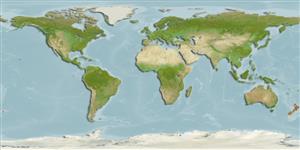分類 / Names
俗名 | 同種異名 | Catalog of Fishes(屬, 種) | ITIS | CoL | WoRMS | Cloffa
Teleostei >
Blenniiformes (Blennies)
鱸形目 (Blennies) >
Tripterygiidae (Triplefin blennies)
三鰭鳚科 (Triplefin blennies) > Tripterygiinae
Etymology: Gilloblennius: Theodore Nicolas Gill (1837-1914) researcher of abyssal fishes and systematics + Greek, blennios = mucus (Ref. 45335).
More on author: Forster.
Environment: milieu / climate zone / depth range / distribution range
生態學
海洋 居於水底的; 深度上下限 0 - 20 m (Ref. 9003). 溫帶
Southwest Pacific: known only from New Zealand.
西南太平洋: 已知只來自紐西蘭了。
大小 / 重量 / 年齡
Maturity: Lm ? range ? - ? cm
Max length : 10.2 cm SL 雄魚/尚未辨別雌雄; (Ref. 13227)
Adults live in subtidal areas and are rarely found in intertidal areas. They feed on organisms which inhabit encrusting rock growths, with amphipods and hermit crabs being the dominant food items (Ref. 26966). Eggs are hemispherical and covered with numerous sticky threads that anchor them in the algae on the nesting sites (Ref. 240). Larvae are planktonic which occur primarily in shallow, nearshore waters (Ref. 94114).
生活在亞潮帶區而且是發現於很少的潮間帶的區域。 吃居住於有硬外殼的岩石成長的生物, 與作為優勢的食物組成的片腳類動物與寄居蟹。 (參考文獻 26966)
Life cycle and mating behavior
Maturities | 繁殖 | Spawnings | Egg(s) | Fecundities | 仔魚
西南太平洋: 已知只來自紐西蘭了。
Fricke, R., 1994. Tripterygiid fishes of Australia, New Zealand and the southwest Pacific Ocean (Teleostei). Theses Zool. 24:1-585. (Ref. 13227)
人類使用
工具
特別的報告
下載 XML
網路資源
Estimates based on models
Preferred temperature (Ref.
123201): 12.9 - 18.3, mean 15.9 °C (based on 113 cells).
Phylogenetic diversity index (Ref.
82804): PD
50 = 0.7500 [Uniqueness, from 0.5 = low to 2.0 = high].
Bayesian length-weight: a=0.00631 (0.00338 - 0.01176), b=3.05 (2.88 - 3.22), in cm total length, based on LWR estimates for this species & (Sub)family-body (Ref.
93245).
營養階層 (Ref.
69278): 3.4 ±0.3 se; based on diet studies.
回復力 (Ref.
120179): 高度, 族群倍增時間少於 15個月 (Preliminary K or Fecundity.).
Fishing Vulnerability (Ref.
59153): Low vulnerability (10 of 100).
